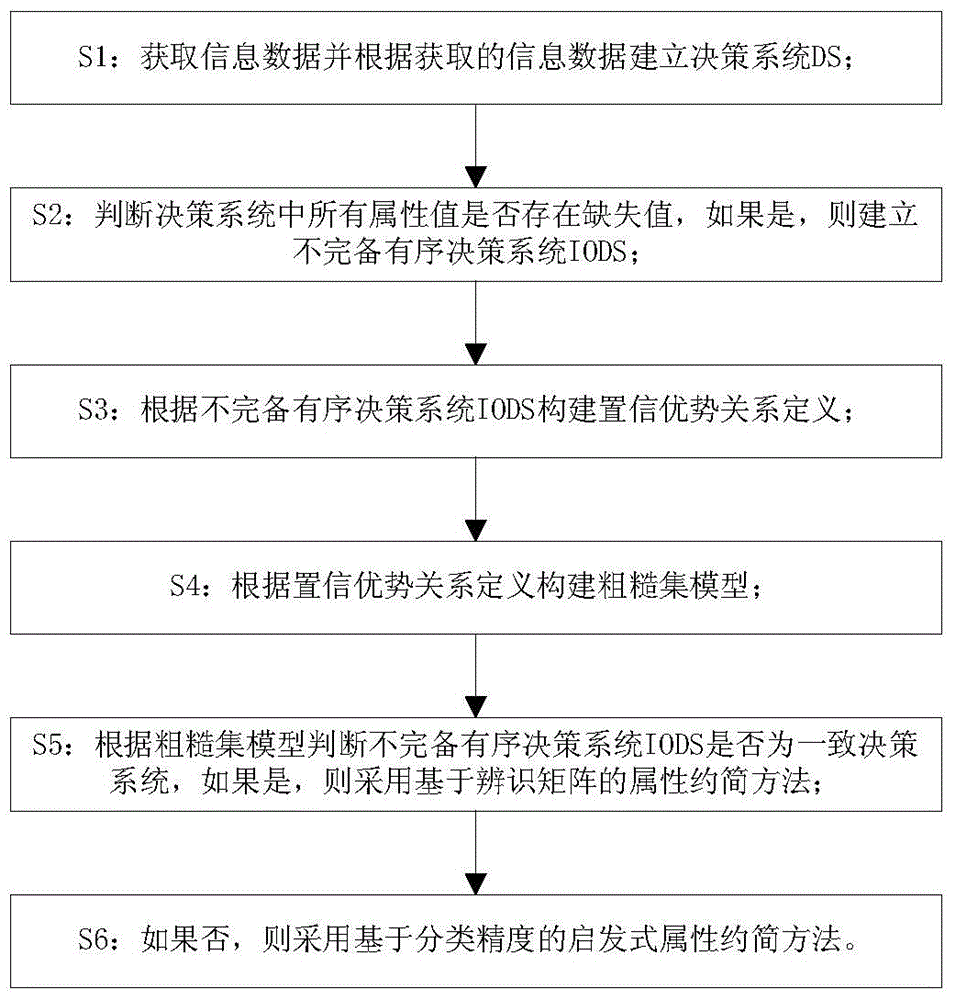Confidence Dominance Relational Rough Set Model and Attribute Reduction Method
A technology of attribute reduction and rough set, applied in special data processing applications, instruments, electrical digital data processing, etc., can solve problems such as incomplete order information, under-consideration of "order" system characteristics, semantic contradictions, etc.
- Summary
- Abstract
- Description
- Claims
- Application Information
AI Technical Summary
Problems solved by technology
Method used
Image
Examples
Embodiment 1
[0070] This example first introduces the existing extended advantage relationship:
[0071] Definition 12: Extended Dominance Relationship,
[0072] use express. The restricted dominance relation is a special form of Definition 12 that allows expansion only at the attribute maximum and minimum values.
[0073] Definition 13: Finite Extended Dominance Relation,
[0074]
[0075] use express.
[0076] Definition 14: Generalized Extended Dominance Relation
[0077]
[0078] use express. The k-degree extension characteristic dominance relation is a special form of Definition 14 that subdivides missing values into two cases for extension.
[0079] Definition 15: Similar Strengths Relationship
[0080] SDR + ( P ) = { ( x , y ) ∈ U 2 : ∀ q ∈ B P ...
Embodiment 2
[0095] figure 1 The flowchart of the confidence-dominant relation rough set model and the attribute reduction method provided by the embodiment of the present invention is as shown in the figure: The confidence-dominant relation rough set model and the attribute reduction method provided by the present invention include the following steps:
[0096] S1: Obtain information data and establish a decision-making system DS according to the obtained information data;
[0097] S2: Determine whether all attribute values in the decision-making system have missing values, and if so, establish an incomplete and ordered decision-making system IODS;
[0098] S3: Construct the definition of confidence advantage relationship according to the incomplete ordered decision system IODS;
[0099] S4: Build a rough set model according to the definition of the confidence dominance relationship;
[0100] S5: According to the rough set model, judge whether the incomplete ordered decision-making sy...
Embodiment 3
[0152] The difference between this embodiment and Embodiment 2 is only:
[0153] The confidence advantage relation rough set model and attribute reduction method provided by the embodiments of the present invention include the following steps:
[0154] S1: Definition of confidence advantage relationship;
[0155]S2: Rough set model based on confidence dominance relation;
[0156] S3: Attribute reduction method based on identification matrix in incomplete consistent information table.
[0157] S4: In the incomplete and inconsistent information table, a heuristic attribute reduction method based on classification accuracy.
[0158] The definition of Confidential Dominate Relation (CDR), which satisfies the characteristics of order relation, satisfies reflexivity, transitivity and order symmetry; the confidence dominance relation defines that the dominance class object of an object A should be better than the known attributes of A , and the amount of known information cannot b...
PUM
 Login to View More
Login to View More Abstract
Description
Claims
Application Information
 Login to View More
Login to View More - R&D
- Intellectual Property
- Life Sciences
- Materials
- Tech Scout
- Unparalleled Data Quality
- Higher Quality Content
- 60% Fewer Hallucinations
Browse by: Latest US Patents, China's latest patents, Technical Efficacy Thesaurus, Application Domain, Technology Topic, Popular Technical Reports.
© 2025 PatSnap. All rights reserved.Legal|Privacy policy|Modern Slavery Act Transparency Statement|Sitemap|About US| Contact US: help@patsnap.com



